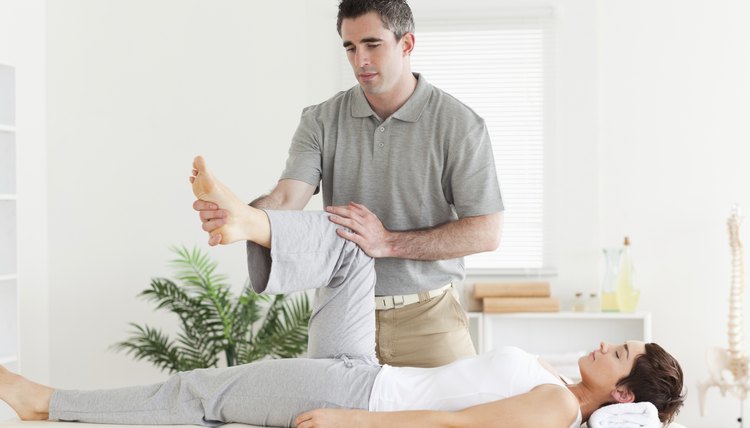Post-Isometric Exercise Relaxation Techniques

There is a fine line between lengthening muscles by gently stretching them, and elongating them to the point of triggering the stretch reflex, a protective response that contracts the muscle, causing the undesirable effect of tightening the targeted muscle. Post-isometric relaxation is a technique designed to relax tight muscles without initiating this reflex. It is helpful in reducing muscle spasms and increasing range of motion.
PIR Defined
Post-isometric relaxation, commonly known as PIR, is used by chiropractors, massage therapists and other trained specialists such as physical therapists. During a session, the therapist passively moves the involved muscle to the end of its length or resistance barrier. At this point, the patient should feel no pain and only a mild stretch, as if the slack has been taken out of their muscle. The patient then resists the stretch, pushing against the therapist’s hand in order to contract the involved muscle. This resistance should be at about 20 percent of the patient’s maximum strength and should last for only seven to 10 seconds. The patient then relaxes. Once the therapist feels the muscle release, she continues the stretch to its next barrier. The process is repeated three to five times, depending on the severity of the muscle spasm or joint restriction.
Muscles in Need
PIR is recommended for the treatment of all postural muscles -- the muscles that enable the body to walk, sit and stand. These muscles maintain the body’s posture against the effects of gravity and have a tendency to become shortened. Several muscles in the upper body fall under this category such as the upper trapezius, the muscles running from the base of the skull to the collarbone; the latissimus dorsi, the broad muscles on each side of the midback; and both pectoralis major and minor, the main chest muscles, to name a few. Common muscles treated in the lower body are the hamstrings, those muscles that run along the back of the thigh; the rectus femoris, one of the muscles that make up the quadriceps; and the adductors, those muscles that have a tendency to tighten up along the inner thigh.
Hamstring Flexibility
A study was conducted with 47 participants ages 20 to 40 at Logan College of Chiropractic to determine whether PIR could reduce hamstring tightness. Tight hamstrings are known to produce lower back pain, and hamstring strains are a common injury, particularly among athletes. Keeping this muscle flexible is considered a preventive measure in minimizing this type of injury. The flexibility of the hamstrings was measured before and after treatment with the sit-and-reach test, a distance measured between the ends of the fingers and toes when sitting with legs extended and reaching for toes. Thirty-nine of the 40 subjects who had tight hamstrings showed an increase in flexibility, as measured by their sit-and-reach scores, after receiving PIR.
Over the Top
Keep in mind to never overstretch when using this technique. If the therapist is lengthening a muscle to the point of pain, it is being overstretched and the therapy is not being performed correctly. The muscle should reach what is known as the restriction barrier, the point where the first sign of resistance is met when the therapist passively moves the muscle. The patient may be slightly sore after PIR therapy, but this should dissipate within a few days.
References
Writer Bio
Marisa Upson has been writing health-related articles since 1990. Her knowledge comes from 23 years in the health care field as a chiropractor and owner of a holistic retreat. Upson holds a Bachelor of Science in human physiology and a Doctor of Chiropractic from Southern California University of Health Sciences.
